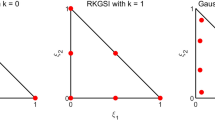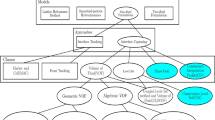Abstract
An improved smooth particle hydrodynamics–finite element method (SPH-FEM) coupling approach was developed for investigating fluid–structure interaction (FSI) problems. To deal with the conjunction of physical quantities at the fluid–structure interfacial region, an interface particle coupling strategy was proposed, in which two kinds of virtual interface particles, i.e., interfacial repulsive particle and associated ghost particle, were arranged to accurately represent the reciprocal interactions between fluid and structure. What is more, a new density correction method combining the δ-SPH and Shepard filter was developed to obtain smoother pressure distribution and to improve numerical stability of SPH calculation. The accuracy and efficiency of the proposed approach were verified through analyzing two typical FSI problems, deformation of an elastic plate subjected to time-varying water pressure and fluid flow in a rolling tank interacting with an elastic beam, and comparing the simulation results with experimental observations and other previously published results. Finally, the proposed coupling approach was further employed to study the fluid sloshing in a motional tank and the influences of baffle in tank on sloshing. Numerical results demonstrate that the proposed improved SPH-FEM approach is applicable to several types of fluid–structure interaction problems with high accuracy and stability.

























Similar content being viewed by others
References
Wan D, Turek S (2007) An efficient multigrid-FEM method for the simulation of solid-liquid two phase flows. J Comput Appl Math 203:561–580. https://doi.org/10.1016/j.cam.2006.04.021
Daude F, Galon P (2018) A Finite-Volume approach for compressible single- and two-phase flows in flexible pipelines with fluid-structure interaction. J Comput Phys 362:375–408. https://doi.org/10.1016/j.jcp.2018.01.055
Ning J, Zhang H, Xu X, Ma T (2021) A novel fluid-structure interaction algorithm for compressible flows and deformable structures. J Comput Phys 426:109921. https://doi.org/10.1016/j.jcp.2020.109921
Bhalla APS, Nangia N, Dafnakis P et al (2020) Simulating water-entry/exit problems using Eulerian-Lagrangian and fully-Eulerian fictitious domain methods within the open-source IBAMR library. Appl Ocean Res 94:101932. https://doi.org/10.1016/j.apor.2019.101932
Benson DJ (1992) Computational methods in Lagrangian and Eulerian hydrocodes. Comput Methods Appl Mech Eng 99:235–394. https://doi.org/10.1016/0045-7825(92)90042-I
Basting S, Quaini A, Čanić S, Glowinski R (2017) Extended ALE Method for fluid-structure interaction problems with large structural displacements. J Comput Phys 331:312–336. https://doi.org/10.1016/j.jcp.2016.11.043
Liu M, Zhang Z (2019) Smoothed particle hydrodynamics (SPH) for modeling fluid-structure interactions. Sci China Phys Mech Astron 62:984701. https://doi.org/10.1007/s11433-018-9357-0
Gingold RA, Monaghan JJ (1977) Smoothed particle hydrodynamics: theory and application to non-spherical stars. Mon Not R Astron Soc 181:375–389. https://doi.org/10.1093/mnras/181.3.375
Lucy LB (1977) A numerical approach to the testing of the fission hypothesis. Astron J 82:1013–1024. https://doi.org/10.1086/112164
Monaghan JJ (1994) Simulating free surface flows with SPH. J Comput Phys 110:399–406. https://doi.org/10.1006/jcph.1994.1034
Ozbulut M, Yildiz M, Goren O (2014) A numerical investigation into the correction algorithms for SPH method in modeling violent free surface flows. Int J Mech Sci 79:56–65. https://doi.org/10.1016/j.ijmecsci.2013.11.021
Felix-Gonzalez I, Sanchez-Mondragon J, Cruces-Giron AR (2022) Sloshing study on prismatic LNG tank for the vertical location of the rotational center. Comput Part Mech. https://doi.org/10.1007/s40571-021-00450-w
Gray JP, Monaghan JJ, Swift RP (2001) SPH elastic dynamics. Comput Methods Appl Mech Eng 190:6641–6662. https://doi.org/10.1016/S0045-7825(01)00254-7
Zhang C, Hu XY, Adams NA (2017) A generalized transport-velocity formulation for smoothed particle hydrodynamics. J Comput Phys 337:216–232. https://doi.org/10.1016/j.jcp.2017.02.016
Chen D, Huang W, Sloan SW (2019) An alternative updated Lagrangian formulation for finite particle method. Comput Methods Appl Mech Eng 343:490–505. https://doi.org/10.1016/j.cma.2018.09.001
Khayyer A, Gotoh H, Falahaty H, Shimizu Y (2018) An enhanced ISPH-SPH coupled method for simulation of incompressible fluid-elastic structure interactions. Comput Phys Commun 232:139–164. https://doi.org/10.1016/j.cpc.2018.05.012
Paggi M, Amicarelli A, Lenarda P (2021) SPH modelling of hydrodynamic lubrication: laminar fluid flow-structure interaction with no-slip conditions for slider bearings. Comput Part Mech 8:665–679. https://doi.org/10.1007/s40571-020-00362-1
Zhan L, Peng C, Zhang B, Wu W (2019) A stabilized TL-WC SPH approach with GPU acceleration for three-dimensional fluid-structure interaction. J Fluids Struct 86:329–353. https://doi.org/10.1016/j.jfluidstructs.2019.02.002
Zhang C, Rezavand M, Hu X (2021) A multi-resolution SPH method for fluid-structure interactions. J Comput Phys 429:110028. https://doi.org/10.1016/j.jcp.2020.110028
Rabczuk T, Belytschko T, Xiao SP (2004) Stable particle methods based on Lagrangian kernels. Comput Methods Appl Mech Eng 193:1035–1063. https://doi.org/10.1016/j.cma.2003.12.005
Liu M, Liu G (2006) Restoring particle consistency in smoothed particle hydrodynamics. Appl Numer Math 56:19–36. https://doi.org/10.1016/j.apnum.2005.02.012
Rabczuk T, Belytschko T (2007) A three-dimensional large deformation meshfree method for arbitrary evolving cracks. Comput Methods Appl Mech Eng 196:2777–2799. https://doi.org/10.1016/j.cma.2006.06.020
Long T, Hu D, Yang G, Wan D (2016) A particle-element contact algorithm incorporated into the coupling methods of FEM-ISPH and FEM-WCSPH for FSI problems. Ocean Eng 123:154–163. https://doi.org/10.1016/j.oceaneng.2016.06.040
Zhang A, Sun P, Ming F, Colagrossi A (2017) Smoothed particle hydrodynamics and its applications in fluid-structure interactions. J Hydrodyn 29:187–216. https://doi.org/10.1016/S1001-6058(16)60730-8
Li Z, Leduc J, Nunez-Ramirez J et al (2015) A non-intrusive partitioned approach to couple smoothed particle hydrodynamics and finite element methods for transient fluid-structure interaction problems with large interface motion. Comput Mech 55:697–718. https://doi.org/10.1007/s00466-015-1131-8
Attaway SW, Heinstein MW, Swegle JW (1994) Coupling of smooth particle hydrodynamics with the finite element method. Nucl Eng Des 150:199–205. https://doi.org/10.1016/0029-5493(94)90136-8
Johnson GR (1994) Linking of Lagrangian particle methods to standard finite element methods for high velocity impact computations. Nucl Eng Des 150:265–274. https://doi.org/10.1016/0029-5493(94)90143-0
Johnson GR, Stryk RA, Beissel SR (1996) SPH for high velocity impact computations. Comput Methods Appl Mech Eng 139:347–373. https://doi.org/10.1016/S0045-7825(96)01089-4
De Vuyst T, Vignjevic R, Campbell JC (2005) Coupling between meshless and finite element methods. Int J Impact Eng 31:1054–1064. https://doi.org/10.1016/j.ijimpeng.2004.04.017
Yang Q, Jones V, McCue L (2012) Free-surface flow interactions with deformable structures using an SPH-FEM model. Ocean Eng 55:136–147. https://doi.org/10.1016/j.oceaneng.2012.06.031
Kalateh F, Koosheh A (2018) Application of SPH-FE method for fluid-structure interaction using immersed boundary method. Eng Comput (Swansea, Wales) 35:2802–2824. https://doi.org/10.1108/EC-01-2018-0041
Fourey G, Hermange C, Le Touzé D, Oger G (2017) An efficient FSI coupling strategy between smoothed particle hydrodynamics and finite element methods. Comput Phys Commun 217:66–81. https://doi.org/10.1016/j.cpc.2017.04.005
Long T, Hu D, Wan D et al (2017) An arbitrary boundary with ghost particles incorporated in coupled FEM-SPH model for FSI problems. J Comput Phys 350:166–183. https://doi.org/10.1016/j.jcp.2017.08.044
Fuchs SL, Meier C, Wall WA, Cyron CJ (2021) A novel smoothed particle hydrodynamics and finite element coupling scheme for fluid-structure interaction: the sliding boundary particle approach. Comput Methods Appl Mech Eng 383:113922. https://doi.org/10.1016/j.cma.2021.113922
Liu M, Shao J, Chang J (2012) On the treatment of solid boundary in smoothed particle hydrodynamics. Sci China Technol Sci 55:244–254. https://doi.org/10.1007/s11431-011-4663-y
Shao S, Lo EYM (2003) Incompressible SPH method for simulating Newtonian and non-Newtonian flows with a free surface. Adv Water Resour 26:787–800. https://doi.org/10.1016/S0309-1708(03)00030-7
Gomes DDSDM, da Hora MD, Nascimento GDC (2021) Application of recent SPH formulations to simulate free-surface flow in a vertical slot fishway. Comput Part Mech. https://doi.org/10.1007/s40571-021-00416-y
Monaghan JJ, Lattanzio JC (1985) A refined particle method for astrophysical problems. Astron Astrophys 149:135–143
Morris JP, Fox PJ, Zhu Y (1997) Modeling low Reynolds number incompressible flows using SPH. J Comput Phys 136:214–226. https://doi.org/10.1002/fld.2600
Antuono M, Colagrossi A, Marrone S, Molteni D (2010) Free-surface flows solved by means of SPH schemes with numerical diffusive terms. Comput Phys Commun 181:532–549. https://doi.org/10.1016/j.cpc.2009.11.002
Violeau D, Rogers BD (2016) Smoothed particle hydrodynamics (SPH) for free-surface flows: past, present and future. J Hydraul Res 54:1–26. https://doi.org/10.1080/00221686.2015.1119209
Rodriguez-Paz M, Bonet J (2005) A corrected smooth particle hydrodynamics formulation of the shallow-water equations. Comput Struct 83:1396–1410. https://doi.org/10.1016/j.compstruc.2004.11.025
Pan K, Ijzermans RHA, Jones BD et al (2016) Application of the SPH method to solitary wave impact on an offshore platform. Comput Part Mech 3:155–166. https://doi.org/10.1007/s40571-015-0069-0
Marrone S, Antuono M, Colagrossi A et al (2011) δ-SPH model for simulating violent impact flows. Comput Methods Appl Mech Eng 200:1526–1542. https://doi.org/10.1016/j.cma.2010.12.016
Antuono M, Colagrossi A, Marrone S (2012) Numerical diffusive terms in weakly-compressible SPH schemes. Comput Phys Commun 183:2570–2580. https://doi.org/10.1016/j.cpc.2012.07.006
Antuono M, Marrone S, Colagrossi A, Bouscasse B (2015) Energy balance in the δ-SPH scheme. Comput Methods Appl Mech Eng 289:209–226. https://doi.org/10.1016/j.cma.2015.02.004
Vacondio R, Rogers BD, Stansby PK (2012) Smoothed particle hydrodynamics: approximate zero-consistent 2-D boundary conditions and still shallow-water tests. Int J Numer Methods Fluids 69:226–253. https://doi.org/10.1002/fld.2559
Lobovský L, Botia-Vera E, Castellana F et al (2014) Experimental investigation of dynamic pressure loads during dam break. J Fluids Struct 48:407–434. https://doi.org/10.1016/j.jfluidstructs.2014.03.009
Adami S, Hu X, Adams NA (2012) A generalized wall boundary condition for smoothed particle hydrodynamics. J Comput Phys 231:7057–7075. https://doi.org/10.1016/j.jcp.2012.05.005
Antoci C, Gallati M, Sibilla S (2007) Numerical simulation of fluid-structure interaction by SPH. Comput Struct 85:879–890. https://doi.org/10.1016/j.compstruc.2007.01.002
Souto-Iglesias A, Botia-Vera E (2012) SPHERIC benchmark test case. In: Tech. Univ. Madrid. http://canal.etsin.upm.es/ftp/SPHERIC_BENCHMARKS/. Accessed 05 March 2022
Idelsohn SR, Marti J, Souto-Iglesias A, Oñate E (2008) Interaction between an elastic structure and free-surface flows: experimental versus numerical comparisons using the PFEM. Comput Mech 43:125–132. https://doi.org/10.1007/s00466-008-0245-7
Svenning E, Mark A, Edelvik F (2014) Simulation of a rubber beam interacting with a two-phase flow in a rolling tank. In: Fontes M, Günther M, Marheineke N (eds) Progress in Industrial Mathematics at ECMI 2012. Mathematics in Industry, vol 19. Springer, Cham, pp 157–165. https://doi.org/10.1007/978-3-319-05365-3_21
Kishev ZR, Hu C, Kashiwagi M (2006) Numerical simulation of violent sloshing by a CIP-based method. J Mar Sci Technol 11:111–122. https://doi.org/10.1007/s00773-006-0216-7
Zheng X, Ma QW, Duan WY (2014) Incompressible SPH method based on Rankine source solution for violent water wave simulation. J Comput Phys 276:291–314. https://doi.org/10.1016/j.jcp.2014.07.036
Acknowledgements
We thank Dr. Ting Long at Guangxi University, Dr. Zhilang Zhang at National University of Singapore and Dr. Ding Chen at Hohai University for their kind advice and helpful suggestions. This work was supported by the National Natural Science Foundation of China [No. 12072104, 51679077] and the Postgraduate Research and Innovation Project of Jiangsu Province (KYCX21_0460).
Author information
Authors and Affiliations
Corresponding author
Ethics declarations
Conflict of interest
On behalf of all authors, the corresponding author states that there is no conflict of interest.
Additional information
Publisher's Note
Springer Nature remains neutral with regard to jurisdictional claims in published maps and institutional affiliations.
Rights and permissions
About this article
Cite this article
Yao, X., Zhang, X. & Huang, D. An improved SPH-FEM coupling approach for modeling fluid–structure interaction problems. Comp. Part. Mech. 10, 313–330 (2023). https://doi.org/10.1007/s40571-022-00498-2
Received:
Revised:
Accepted:
Published:
Issue Date:
DOI: https://doi.org/10.1007/s40571-022-00498-2




